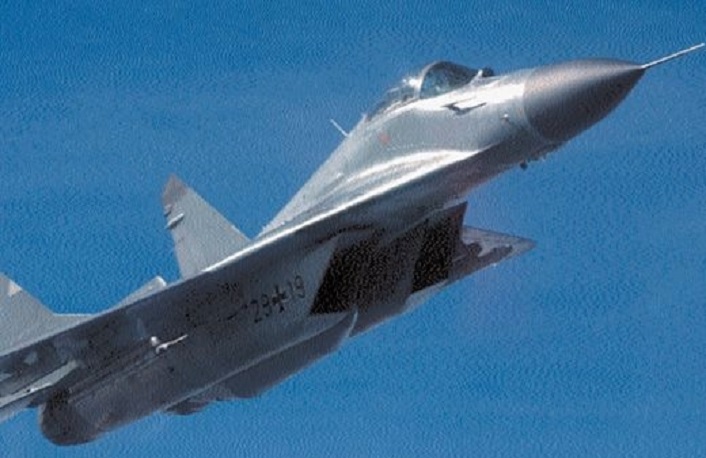“Nothing can simulate the Fulcrum like a real Fulcrum. It was incredible to look across the BFM circle, see a real MiG-29 and hear the German pilot in his accent call `schlem’ [German term for sensor lock]. The ability to fight against his jet, the Archer and HMS was awesome.”
The following article, titled Agile Archer 2002: Training MiG Killers and written by Cdr. Nick Mongillo, appeared in the March-April 2003 issue of Naval Aviation News.
From Sep. 4 to Oct. 5, 2002, Exercise Agile Archer pitted Navy F/A-18 Hornets, F-14 Tomcats, and F-5 Tiger IIs against German Air Force (GAF) MiG-29 Fulcrums and U.S. Air Force F-15 Eagles in the skies over NAS Key West, Fla.
The culmination of two years of planning, Agile Archer was the first joint/combined exercise of its kind held in the United States. It was designed to enhance the basic fighter maneuvering (BFM) skills of American pilots.
Sixteen Navy squadrons and 92 Naval Aviators participated in the exercise, from the Naval Strike and Air Warfare Center (NSAWC); type wing weapons schools; Strike Fighter Squadrons 27, 82, 86, 106, 122, 131, 136, 147, 195, and 197; Fighter Squadrons 11 and 101; and Composite Fighter Squadrons 12 and 13. During the month-long training detachment, the Navy executed over 200 dedicated one-versus-one sorties against Fulcrums from the JG 73rd Fighter Wing home-based in Laage, Germany, and Eagles from the Florida Air National Guard (FANG).
The Fulcrum represents the Russian counterpart of the modern Western fighter. It carries a capable pulse doppler radar, AA-10 Alamo radar air-to-air missiles, and the GSH-301 30mm cannon. In addition, the combination of the MiG-29’s AA-11 Archer heat-seeking missiles and helmet-mounted-sight (HMS) cueing system gives the fighter a high off-boresight, within-visual-range (WVR) weapon capability that at the time had no fielded equal in the West. The experience of the Fulcrum pilots—the majority of whom previously flew the F-4 Phantom and received pilot training in the United States—combined with the MiG-29’s technical capability equated to a most formidable air-to-air adversary.
For almost 10 years the JG-73 Fighter Wing flew as an aggressor squadron for NATO, training Western fighter squadrons in air combat against the Fulcrum. In addition to their aggressor role, all GAF MiG pilots had expert systems knowledge and briefed the exercise’s participants on the MiG’s combat systems, capabilities, and limitations.
The Navy’s goal for Agile Archer 2002 was to expose as many aircrew personnel as possible to the MiG-29. During a routine BFM training flight, Navy adversary pilots simulated the Fulcrum by flying specific flight profiles. However, no simulation, no matter how accurately flown, can replace the real thing. The Navy leadership wanted its aircrews to observe the MiG up close, indirect simulated combat, with a skilled Fulcrum pilot at the controls employing HMS and Archer.
A typical one-versus-one Fulcrum sortie consisted of one beyond-visual-range (BVR) intercept and two full-up BFM engagements. The BVR intercept allowed the Navy aircrew to practice visual identification against the MiG. During the intercept, the aircrew noted radar detection range, radar warning receiver indications from the MiG’s Slotback radar, positive identification capability, and the ability to defeat the MiG’s radar and heat-seeking missiles. The BFM engagements permitted the Navy aircrew to experiment with one-circle and two-circle game plans and provide insight into the MiG’s slow flight characteristics, visual signature, imposing HMS/Archer off-boresight capability, and impressive energy addition. All engagements with the MiG allowed the Navy aircrew to validate current tactical recommendations and the Strike Fighter Weapons and Tactics (SFWT) training program. Detachment pilots unanimously agreed that Navy schools taught the appropriate tactics to counter the MiG-29’s capabilities and provide the foundation for success in combat.
Upon return from a MiG-29 dogfight, one Navy pilot commented on the value of the exercise: “Nothing can simulate the Fulcrum like a real Fulcrum. It was incredible to look across the BFM circle, see a real MiG-29, and hear the German pilot in his accent call `schlem’ [German term for sensor lock]. The ability to fight against his jet, the Archer, and HMS were awesome. This was the best training I ever received in the Navy.”
Navy aircrews also fought the Florida Air National Guard’s slick F-15s. The FANG comprised a wealth of experienced pilots, including combat veterans, Fighter Weapons School instructors and graduates, and several 3,000-hour Eagle drivers. A typical one-versus-one Eagle sortie consisted of two to three BFM hacks. Aircrews opted between perch and high-aspect sets, with most choosing the high-aspect option. Butterfly sets facilitated aircrew experimentation with a variety of game plans.
Navy detachment pilots cited impressive Eagle thrust-to-weight ratios and the ability to put knots on, fast! Eagle drivers liked the Hornet’s ability to square the corner and intimidate with the nose. The detachment pilots unanimously agreed that success in the WVR-BFM arena depended solely on the pilot’s ability, regardless of the modern fighter flown.

The unique exercise helped Navy aircrews hone their skills against a formidable adversary, making them more lethal and capable of defeating a MiG-29 in combat. The participants left with lessons learned to be passed to squadron mates, fleet replacement squadron members, SFWT students, Strike Fighter Advanced Readiness Program squadrons, and air wings conducting training on ranges at NAS Fallon, Nev.
Photo by Erik Hildebrandt / U.S. Navy

